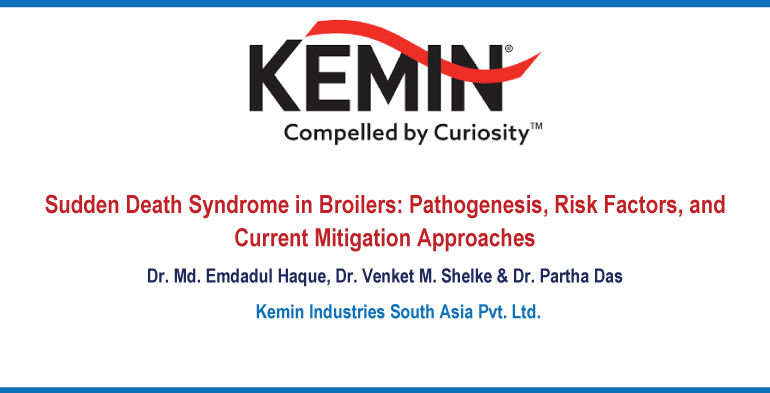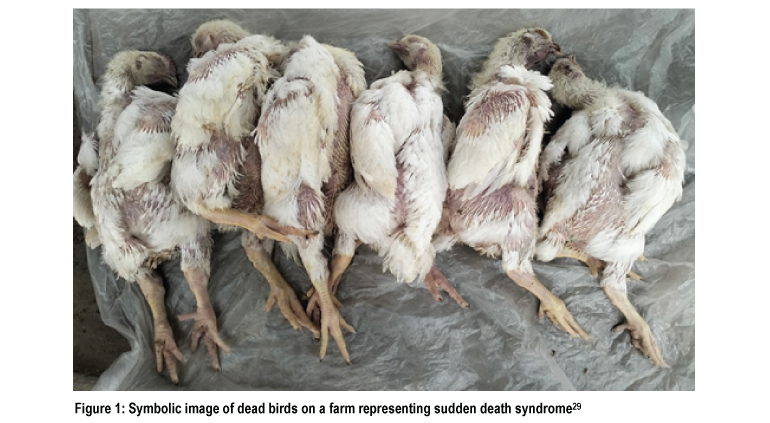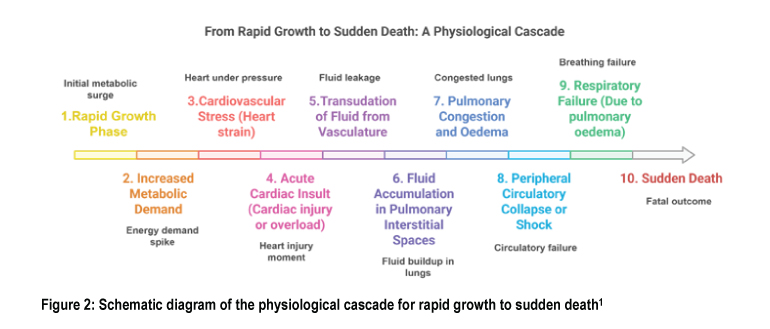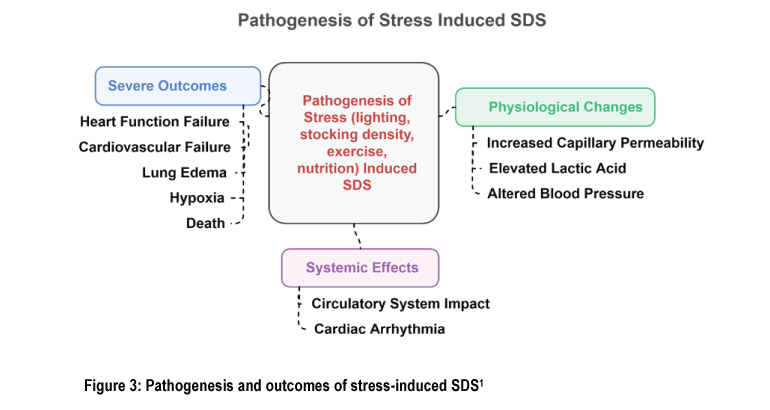
Introduction:
Sudden Death Syndrome (SDS) in poultry, primarily affecting fast-growing broiler chickens, is a metabolic disorder characterized by the sudden and unexplained death of healthy birds. It predominantly occurs in male chickens, particularly those raised in intensive production systems, and is most common between 2 and 4 weeks of age, with an incidence ranging from 0.5% to 5% of affected flocks1.
Sudden Death Syndrome (SDS), also known as Morte subita, Acute death Syndrome, Dead in good condition, Heart attack, or Lung Edema, is a condition commonly observed in fast-growing broiler chickens2. SDS is sometimes referred to as "flip-over disease" because affected birds often flip onto their backs, dying with their wings outstretched and legs extended2. Affected chickens experience a rapid onset of imbalance, intense flapping, and muscular contractions lasting around 53 seconds before death3.
Sudden Death Syndrome (SDS) in modern broiler chicken production represents a significant concern due to its impact on mortality rates and overall economic losses, particularly at the end of the fattening period4. SDS results in direct financial losses through bird fatalities and induces indirect costs, including uneven flock growth, higher feed conversion ratios, and increased labor and veterinary expenses. The industry's focus on achieving rapid growth, and feed efficiency to meet rising global poultry demand inadvertently intensifies the risk of SDS. Addressing this issue is crucial for both animal welfare and production efficiency, as well as for the sustainability and profitability of poultry operations. Mitigating SDS is vital for maintaining economic returns and meeting global food security needs. A comprehensive understanding of its etiology, pathogenesis, pathophysiological symptoms, and diagnostic strategies is necessary. Implementing targeted prevention measures and best management practices will help reduce SDS prevalence, safeguard flock health, and ensure long-term sustainability in poultry production.
Etiology and pathogenesis of SDS
Sudden death syndrome in broilers is influenced by various factors like nutrition, genetics, and environment. However, the primary trigger is acute cardiac arrhythmia, which causes fatal reactions in birds1.
Genetic and Metabolic Influences
Rapid growth rates in genetically selected broilers significantly heighten the risk of ascites and sudden death syndrome (SDS) due to disproportionate metabolic oxygen demand1. This outpaces the development of cardiac and pulmonary systems, leading to functional insufficiency and increased SDS susceptibility1.
SDS is recognized as a metabolic disorder wherein disturbances in metabolite or electrolyte homeostasis precipitate ventricular fibrillation, ultimately resulting in mortality1. Contemporary perspectives emphasize that SDS is primarily driven by metabolic dysregulation, not necessarily due to accelerated weight gain, but rather due to elevated systemic oxygen demands. This heightened demand induces disruptions in electrolyte equilibrium and systemic acid-base balance. Consequently, acute alterations in electrolyte concentrations and blood pH are considered critical triggers for the onset of SDS1.

SDS causes sudden mortality in broiler chickens, primarily due to the acute cardiac stress that leads to pulmonary oedema and respiratory failure1

Modern, fast-growing broiler strains are increasingly prone to cardiovascular anomalies, contributing to higher mortality rates linked to cardiac dysfunction21. Sudden Death Syndrome (SDS), primarily attributed to cardiac arrhythmias, is common in these genetically selected birds2. The condition is exacerbated by accelerated muscle growth, heightening the risk of arrhythmic events2. Heritability studies suggest a strong correlation between SDS, body weight, and ascites incidence, highlighting genetic predisposition as a key factor28.
Occurrence Patterns and Incidence Rates
The occurrence and incidence of SDS in broilers vary, typically affecting birds from 2-3 days of age to market age, with peak mortality occurring between 21-28 days2,5. Males are more susceptible, accounting for 60-80% of deaths, likely due to their higher growth rates and hormonal factors7. Mortality rates range from 0.5 to 5% in affected flocks5
Diet Texture and Composition
The form of diet affects feed intake, metabolic rate, and the risk of metabolic diseases like SDS. While mash diets reduce SDS incidence, they also slow growth, which is not ideal. Pelleted feeds increase feed intake and growth rate, raising SDS risk9. Some studies suggest that pelleting protein supplements, especially soybean meal, may produce toxins linked to SDS, but including meat meals may offer some protection against it5. However, this remains unclear.
Diet composition plays a crucial role in the incidence of SDS in poultry. Studies suggest that replacing carbohydrates with lipids, such as glucose, lipids, and corn starch, may influence SDS mortality5. Additionally, low-density diets have been found to reduce SDS mortality compared to high-density diets10. Furthermore, feed formulations with more wheat and less corn are associated with higher SDS incidence5. These findings indicate that diet composition, including energy sources, can impact SDS occurrence and body weight in poultry.
Nutritional factors
Protein & Amino Acid
Dietary protein appears to have a limited direct effect on Sudden Death Syndrome (SDS), with protein-deficient diets potentially reducing SDS incidence, though at the cost of growth and increased fat deposition5. High-protein diets with excess sulfur may promote acid secretion and lactic acid buildup, contributing to SDS. Taurine, an amino acid, influences heart health, and its deficiency could lead to heart failure and SDS, although its precise role remains uncertain11. Additionally, the use of meat meals in diets has been associated with a reduced SDS incidence, suggesting the presence of unidentified factors in meat meals that help mitigate SDS5.
Lipids
The type and level of dietary lipids, particularly the balance between saturated and unsaturated fats, may influence the incidence of Sudden Death Syndrome (SDS) in broilers12. Studies show that broilers fed saturated oils have lower SDS occurrence, and those fed sunflower oil experience less mortality than those fed tallow13.
Maternal intake of n-3 polyunsaturated fatty acids (PUFAs) influences offspring myocardial tissue composition, reducing Eicosanoid production and SDS risk14. High metabolic rates in broilers increase free radical formation, contributing to SDS5. Melatonin supplementation may reduce SDS by counteracting high-intensity light’s inhibitory effect on melatonin production5. Additionally, low Linoleic and Arachidonic acid levels in heart tissue impair prostaglandin synthesis, increasing SDS susceptibility5.
Carbohydrates and Lactate
The pathogenesis of SDS is significantly influenced by the type and availability of carbohydrates, rather than by proteins or fats8. Research shows that different carbohydrate sources, such as glucose and corn starch, impact mortality rates, likely due to their effect on lactic acid metabolism5. Elevated levels of Lactate Dehydrogenase (LDH), Glutamic Oxaloacetic Transaminase, and Creatine Phosphokinase are indicators of circulatory disturbances and are often associated with SDS15. Inadequate oxygen due to poor organ growth (heart and lungs) exacerbates lactate production, resulting in muscular contractions, imbalance, and ultimately, violent flapping, contributing to SDS onset.
Minerals
Stress conditions, such as lighting and stocking density, are proposed to increase Catecholamine secretion from the adrenal gland, elevating catecholamine and calcium ion levels in cardiac muscle, potentially leading to cardiac arrhythmias6. Selenium deficiency is also considered a cause of Sudden Death Syndrome (SDS) in broilers, likely due to its antioxidant properties5. Additionally, high dietary saturated fatty acids can bind with minerals like magnesium, calcium, and zinc, reducing their bioavailability, affecting the nervous system, and possibly causing SDS-like conditions8.
Vitamins
There is limited evidence suggesting that vitamin deficiencies, particularly B vitamins like biotin, may influence the incidence of Sudden Death Syndrome (SDS) in broilers5. Higher SDS rates have been observed in flocks fed wheat, potentially due to biotin deficiency in wheat. Supplementing biotin through corn or wheat may reduce mortality, although the required amount is typically met with the diet’s premix5.
Excessive supplementation of vitamin D3 in broiler diets, often aimed at preventing leg disorders, may paradoxically increase the risk of Sudden Death Syndrome (SDS)1. High vitamin D3 levels disrupt cardiac morphology and electrophysiology, promoting arrhythmias1. Coupled with rapid growth and mineral imbalances, this significantly elevates the susceptibility of broilers to SDS.
Stress
Recent studies suggest that stress is a major contributor to Sudden Death Syndrome (SDS) in broiler chickens, with arrhythmia-inducing stress playing a key role1. Stress can exacerbate SDS symptoms, and mortality may occur days after the stressor.

Drugs
The pathogenesis of Sudden Death Syndrome (SDS) in broiler chickens related to anti-coccidiosis drugs, particularly Ionophores, involves several steps16,17,5
Ionophores like Monensin impact ion transport (Sodium, Potassium, and Hydrogen ions)
Disruption of membrane permeability and acid-base imbalance
Altered ion gradients and acid-base balance
Degeneration of heart muscles due to an imbalance
Increase susceptibility to Sudden Death Syndrome (SDS).
Pathophysiological Symptoms and Diagnosis of SDS
Identifying birds susceptible to Sudden Death Syndrome (SDS) remains challenging, as current methods, including electrocardiograms, temperature monitoring, and behavioral observations, are insufficient. Histopathological changes in the heart may help identify structural traits that predispose broilers to lethal arrhythmia2, but further research is needed for a conclusive diagnosis.
Clinical Signs
• Birds initially exhibited normal feeding, drinking, and walking behavior before death, followed by neck extension, squawking, and wing beating, with death occurring within minutes6.
• All affected birds experienced a sudden onset of symptoms, including loss of balance, violent wing flapping, and strong muscular contractions, with seizures lasting less than one minute. Most birds emitted high-pitched cries or squawks during these episodes18.
Post-mortem Findings:
Upon necropsy, a structure was found within the heart's blood, which was histologically identified as "Jelly clots" or "chicken fat clots," both of which are characteristic of post-mortem formation6.
• Lungs: Exhibiting oedema.
• Kidneys and Liver: Slight congestion and subcapsular petechial hemorrhage. The liver appears enlarged with fatty infiltration.
• Heart: Firm and contracted, with enlargement. The ventricles are empty, and the atria are filled with blood clots, which are deemed to have a post-mortem origin.
• Crop and Gizzard: Containing recently ingested food.
• Gall Bladder: Empty, suggesting the bird had eaten before death.
Microscopic Lesions
• Lungs: Exhibiting varying degrees of vascular engorgement, with the presence of red blood cells (RBCs) and edema in both intestinal and interlobar connective tissues6.
• Liver: At the portal triad, there is leucocyte infiltration, causing distortion and reduction in the lumen of the bile duct6.
• Heart: Degeneration of myofibrils accompanied by leukocyte infiltration (primarily lymphocytes and heterophils). Edema is present, leading to the separation of myofibrils6.
Biochemical studies
• Elevated blood lactic acid levels may contribute to Sudden Death Syndrome (SDS) in broiler chickens by damaging the cardiovascular system, increasing the risk of mortality1,19.
• High calcium ion levels, along with increased catecholamine and adrenaline, have been observed in heart muscles of birds with sudden death syndrome, along with thyroid hormone changes20,21.
• Elevated creatine kinase levels in broiler chickens, often seen under stress, serve as an indicator of cardiac disturbances and an increased risk of Sudden Death Syndrome (SDS), reflecting potential myocardial damage21.
• Elevated levels of lactate, lactate dehydrogenase (LDH), glutamic oxaloacetic transaminase (GOT) and creatine phosphokinase in the cardiac muscle are key metabolic and molecular indicators of Sudden Death Syndrome (SDS) in broiler chickens, which can aid in identifying affected birds15.
Molecular studies
• Caspase enzymes, particularly caspase-3, play a key role in regulating apoptosis and inflammation, with increased caspase activity observed in heart tissue damage, suggesting that measuring caspase-3 expression could help identify animals at high risk for Sudden Death Syndrome due to cardiac defects2.
• Mutations in the RYR2 (Ryanodine Receptor 2) gene, which regulates calcium release in heart cells, have been linked to increased susceptibility to cardiac arrhythmia and Sudden Death Syndrome (SDS) in broiler chickens, suggesting that identifying these mutations could help reduce SDS mortality in poultry22.
Prevention of SDS
• The form of feed, nutrient content, and feed additives may play a role in reducing Sudden Death Syndrome (SDS) mortality in broiler chickens, with some studies suggesting that mash feeding can slow growth and reduce cardiac defects, although other research found no impact of feed type on SDS incidence1,10.
• Feed restriction has been shown to reduce the incidence of Sudden Death Syndrome (SDS) in broiler chickens, with studies indicating lower SDS mortality in restricted-fed birds compared to ad libitum feeding; however, the negative impact on growth performance and other factors limits its recommendation for commercial production2.
• Limiting the energy level and nutrient concentration in feed can improve broiler welfare and reduce Sudden Death Syndrome (SDS) mortality, especially in older birds, though some studies suggest that diet type may have little effect on SDS incidence1,10.
• Plant extracts, such as thyme oil and Echinacea purpurea juice, show potential in improving cardiovascular function and reducing mortality in poultry, including lowering cholesterol and triglyceride levels, and decreasing the risk of Sudden Death Syndrome, though further research is needed for practical application in poultry breeding23,24.
• Supplementing broiler chicken diets with vitamins such as E, selenium, B-complex, or multivitamin electrolytes has been found effective in reducing the incidence of Sudden Death Syndrome25.
• Probiotics have been shown to reduce blood lipid metabolites, potentially decreasing metabolic disorders and indirectly lowering the incidence of Sudden Death Syndrome in broiler chickens26.
• Adding rapeseed oil or fish oil to broiler chicken diets, both rich in omega-3 fatty acids, can reduce the risk of Sudden Death Syndrome by preventing cardiac arrhythmia. A 3% rapeseed oil supplement significantly boosts EPA (Eicosapentaenoic acid) and DHA (Docosahexaenoic acid) levels in heart phospholipids, providing protection against SDS, with rapeseed oil being a more affordable option that doesn’t impact meat aroma1.
• Supplementing broiler chicken diets with Guanidinoacetic acid (GAA) may help reduce the incidence of Sudden Death Syndrome by protecting against lactic acidosis, though it also negatively impacts growth, indicating that more effective SDS prevention methods are still needed19.
• To reduce Sudden Death Syndrome (SDS) in broiler chickens, it is crucial to manage stocking density and ambient temperature1.
• The photoperiod length significantly affects Sudden Death Syndrome (SDS) in broiler chickens, with longer periods beyond 10 hours increasing mortality, while appropriate lighting programs and increased melatonin secretion may help mitigate stress-related cardiac arrhythmia, reducing the risk of SDS27.
Conclusion
Sudden Death Syndrome (SDS) in broiler chickens remains a complex issue influenced by a variety of nutritional, environmental, and genetic factors. While nutritional strategies, such as adjusting energy intake and providing appropriate vitamins and minerals, may help reduce SDS incidence, the overall impact is limited. Stress, particularly related to genetics, nutrition, and management, plays a central role in SDS development. Although current prevention methods can reduce SDS mortality, they often result in decreased production efficiency. Further research is needed to better understand SDS's underlying causes and develop effective prevention strategies that balance animal welfare and production profitability.






